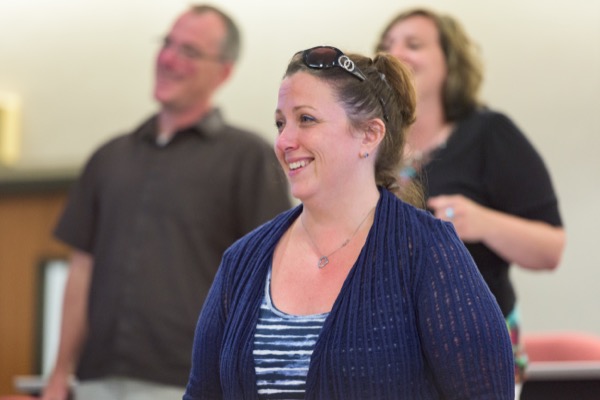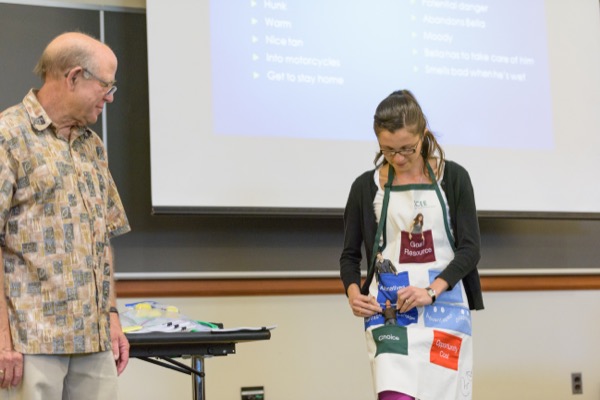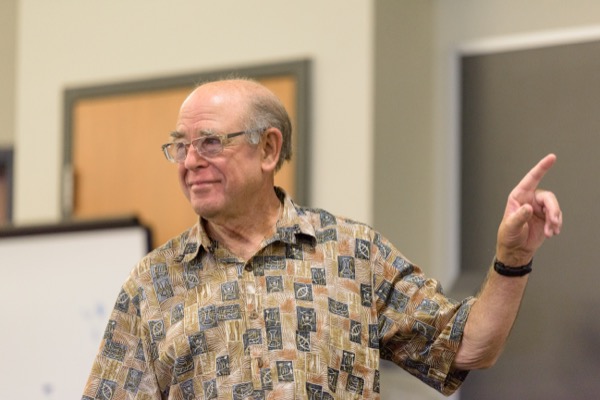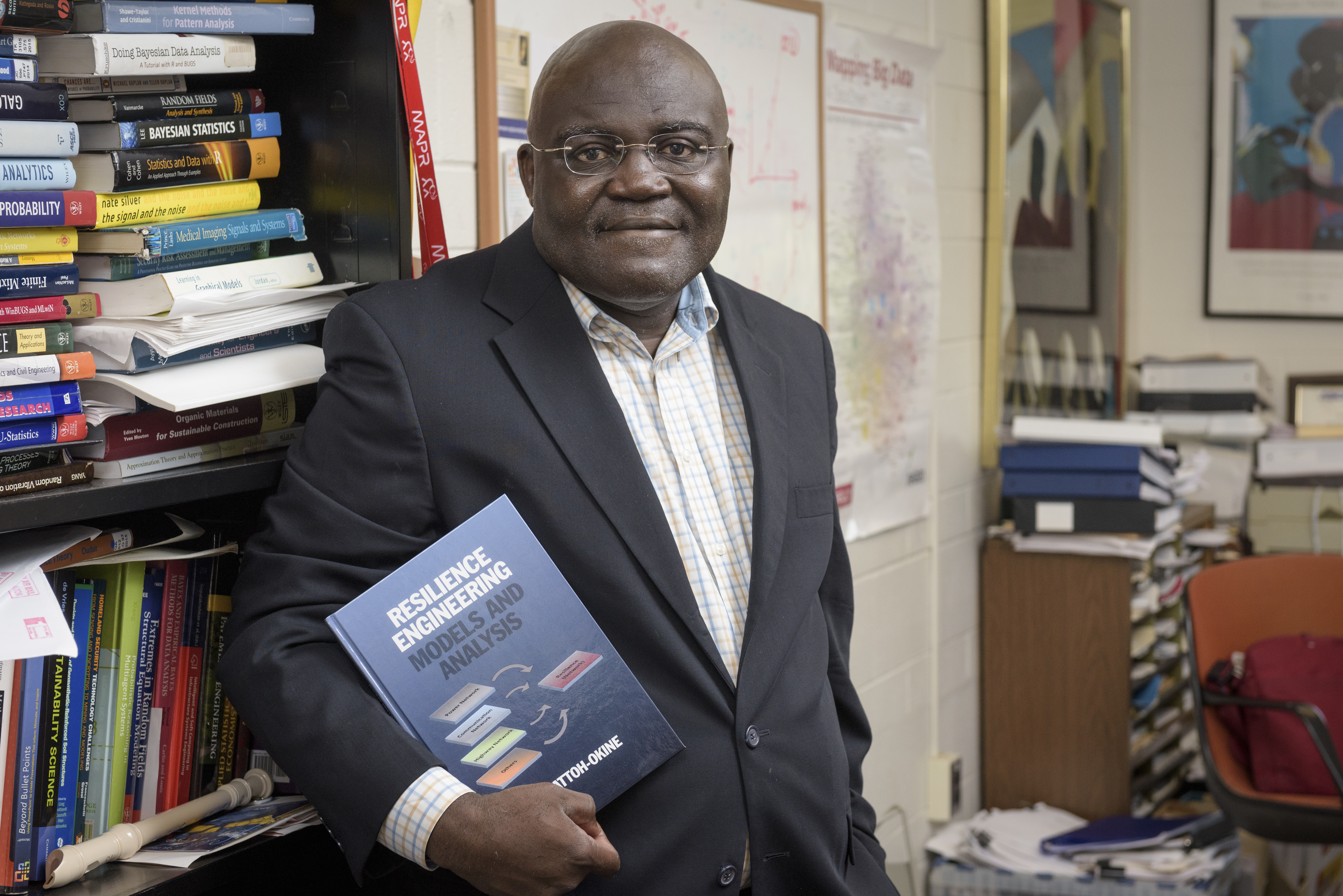

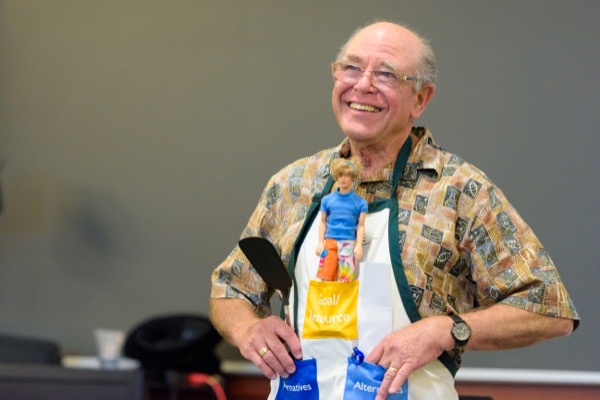
Enthusiastic educators
Leading economics educator shows teachers how to create fun, hands-on lessons
2:19 p.m., July 16, 2015--A rabbit in a hat, an apron, a mirror, a set of Twilight action figures and a cap and gown-wearing stuffed alligator singing “Get This Party Started.”
These seemingly random items were only some of the tools that legendary economics educator Jim Charkins utilized during his two presentations last week at the University of Delaware.
People Stories
'Resilience Engineering'
Reviresco June run
But Charkins’ props are far from frivolous. In fact, they are critical components of a hands-on teaching style that gets students excited about economics and how they can use economic skills to improve their lives.
Charkins, who serves as director of the Center for Economic Education at California State University, San Bernardino, discussed his methods with this year’s new cohort of students in the Master of Arts in Economics and Entrepreneurship for Educators (MAEEE) program in UD’s Alfred Lerner College of Business and Economics.
Students earning an MAEEE degree, offered through the Lerner College’s Center for Economics Education and Entrepreneurship (CEEE), are dedicated K-12 teachers learning strategies for teaching economics, entrepreneurship and personal finance. This year’s cohort of MAEEE students includes 11 Delaware teachers and teachers from 16 states, as well as one student who is a Canadian currently teaching in China.
Charkins began his presentations to the MAEEE students by suggesting that they rethink their in-classroom definition of the word “economics.”
“When I was an undergraduate, I learned that economics is ‘the study of production, consumption and distribution of scarce resources and goods and services among alternative uses,’” Charkins said. “That’s true; it’s accurate. But what does it mean to a 17- or an 18-year-old?”
Instead, Charkins said that he defines economics as “using scarce resources as efficiently as possible to achieve goals,” a definition that is more relevant to students and their daily lives.
This is part of Charkins’ ultimate goal of teaching students to use economic principles to improve their futures.
“Why should my students learn this? What is it about this that’s going to help them survive, prosper and achieve their goals?” Charkins said that these are critical questions that teachers should ask each day.
It’s also important, he said, that teachers help students to understand their incredible potential.
“When we’re talking about resources, I always ask, ‘What’s the most important resource that our society has?’” Charkins said.
And then he held up a mirror.
“Every one of them sees their face in the mirror. Why? Because they are the most important resource that this nation has.”
When discussing this idea, Charkins teaches his students how economic terms apply directly to their lives. By finishing high school and pursuing college or job training, for example, students are “developing their human capital.”
“You’re in school to improve your incredible human capital, to use that human capital and other resources to achieve your goals and lead a good life,” Charkins said. “You’re in school for you. If we can be effective at convincing students of that, we’ll lower the dropout rates.”
And this starts with getting students interested and passionate about learning.
In this vein, Charkins walked the MAEEE students through a number of informative but fun demonstrations that he uses in his own classroom.
For example, Charkins used the apron and Twilight action figures to teach the concepts of choice and opportunity cost, framing the love story through alternatives, advantages and disadvantages.
When K-12 students participate in activities like these, they laugh and have fun while paying attention and learning important concepts. And the same can be said for the MAEEE students who practiced these teaching methods with Charkins.
“Dr. Charkins’ passion for economic education was infectious, and I learned many strategies that I can implement in my class this fall,” said MAEEE student Erin Sullivan, who teaches at Cab Calloway School of the Arts in Wilmington, Delaware.
Perhaps this is why CEEE associate director Bonnie Meszaros calls Charkins “the ultimate teacher’s teacher.”
“He has a rare skill of being able to teach sophisticated concepts in a way that is fun and entertaining without compromising on the depth of content needed for teachers to correctly teach their K-12 students,” said Meszaros.
CEEE director Carlos Asarta agreed, saying, "Prof. Charkins is a master educator who is a leader in the field of economic education and is passionate about teaching economics to teachers.”
“His experience as past president of the California Council on Economic Education, professor with the Foundation for Teaching Economics and economics editor of the Wall Street Journal Classroom Edition Teacher Guide provides him with the expertise to make economics interesting, relevant and a tool teachers can use to explain the world we live in."
Article by Sunny Rosen
Photos by Evan Krape




